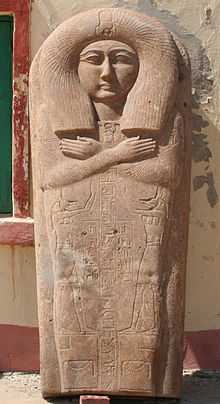Hornakht
| Hornakht Prince | |
|---|---|
 The sarcophagus lid of Hornakht | |
| Dynasty | 22nd Dynasty |
| Pharaoh | Osorkon II |
| Father | Osorkon II |
| Mother | Karomama I |
| Burial | Tanis, NRT I |
Prince Hornakht (or Harnakht) was the son of pharaoh Osorkon II of the 22nd Dynasty. He was appointed by Osorkon II to the office of chief priest of Amun at Tanis to strengthen this king's authority in Lower Egypt. However, this was primarily a political move on Osorkon II's part since Hornakht died before the age of 10.[1]
When Hornakht died at this young age, Osorkon II made provisions to ensure that his son would be buried in this king's own tomb at Tanis. While tomb robbers managed to penetrate the burial of Hornakht in antiquity, his sarcophagus still preserved parts of the tomb treasures which were once placed upon the prince's mummy since a large granite block placed over Hornakht's burial prevented them from lifting its lid completely. Secondly, most of the grave robbers attention were focused upon the sarcophagus of Osorkon II which would have featured vastly more splendid treasures.[2]
The grave robbers succeeded in removing the gold funerary mask which covered Hornakht's face as well as some ornaments which adorned his neck; however, they abandoned their efforts to steal the remainder of the prince's funerary treasures. Therefore, when Egyptologists discovered the burial of Hornakht, they found a series of gold amulets which covered parts of the prince's mummy. They are small in size but enjoy a high quality finish; some are made of gold partitioned lapis lazuli and other semi-precious stones which represent various mythical symbols intended to safeguard the sanctity of Hornakht's mummified body.[3]
A block statue from the Serapeum at Saqqara may well have been dedicated to Hornakht. The statue is decorated with relief images of queen Karomama I, Hornakht’s mother, and of the god Amun-Ra (besides other divinities). The sculpture now has a figure of Osiris at the front (re-cut from what appears to have represented a naos once) and was probably set up not long after the prince’s premature death.[4]
References
- ↑ Nicolas Grimal, A History of Ancient Egypt, Blackwell Books, 1992. p.325
- ↑ Georges Goyon, La découverte des trésors de Tanis, Pygmalion, 2004. pp.124-126
- ↑ Henri Stierlin, L’Or des Pharaons, Éd. Pierre Terrail, Paris, 1993. pp.208-209 & 211
- ↑ Helmut Brandl: Untersuchungen zur steinernen Privatplastik der Dritten Zwischenzeit: Typologie, Ikonographie, Stilistik. MBV, Berlin 2008, ISBN 978-3-86664-482-3, pp. 243-245 → Dok. U-5.1, pl. 141, 184.f. (Dissertation, Humboldt-Universität Berlin 2003)
External links
| Wikimedia Commons has media related to Hornakht. |
- The Tomb of Hornakht
- The Canopic jars of Prince Hornakht National Gallery of Art